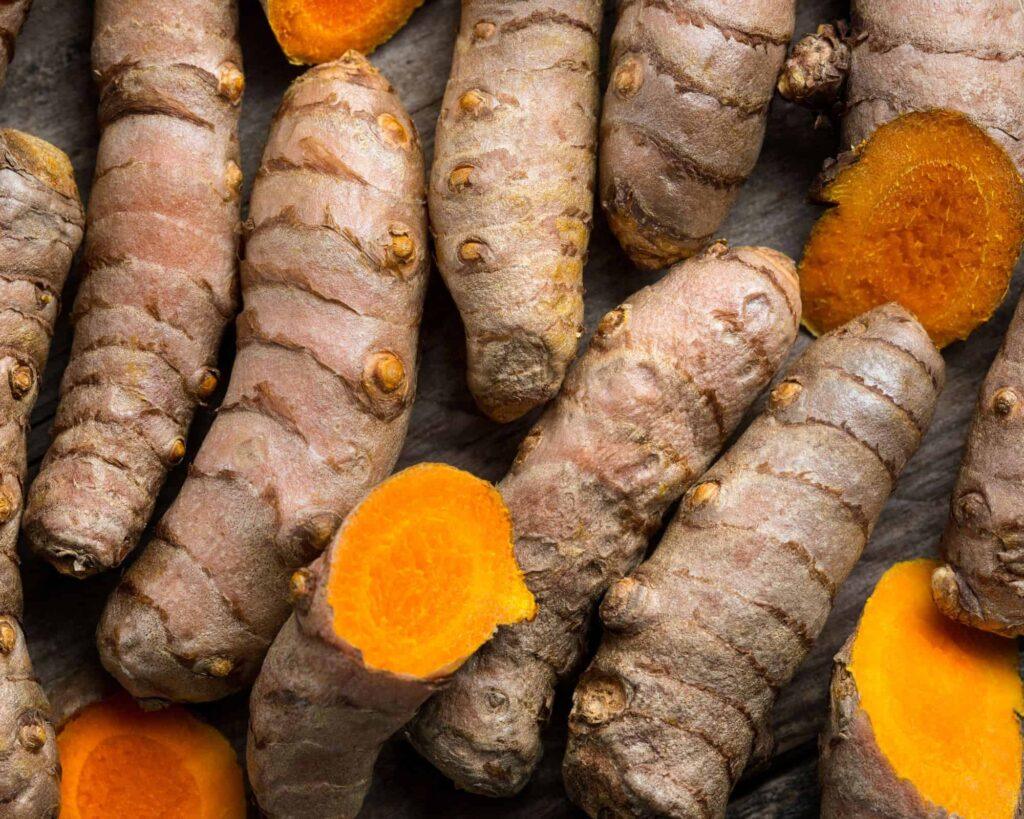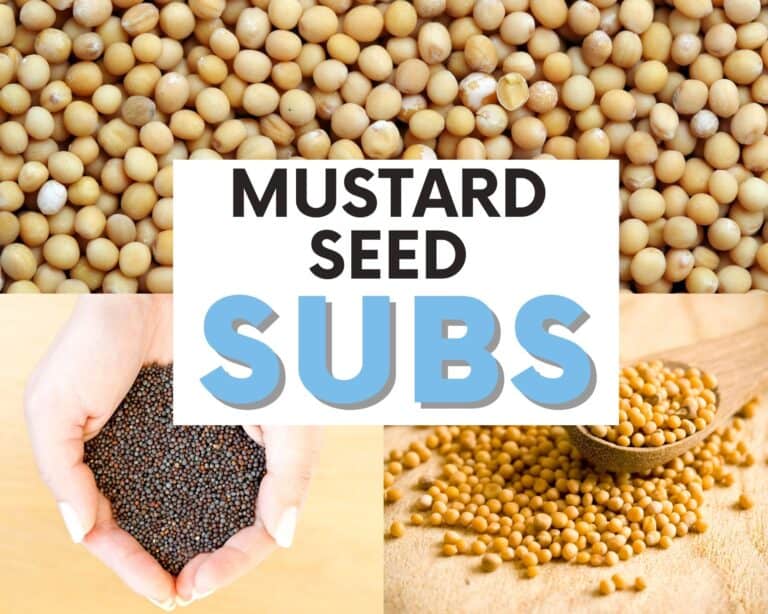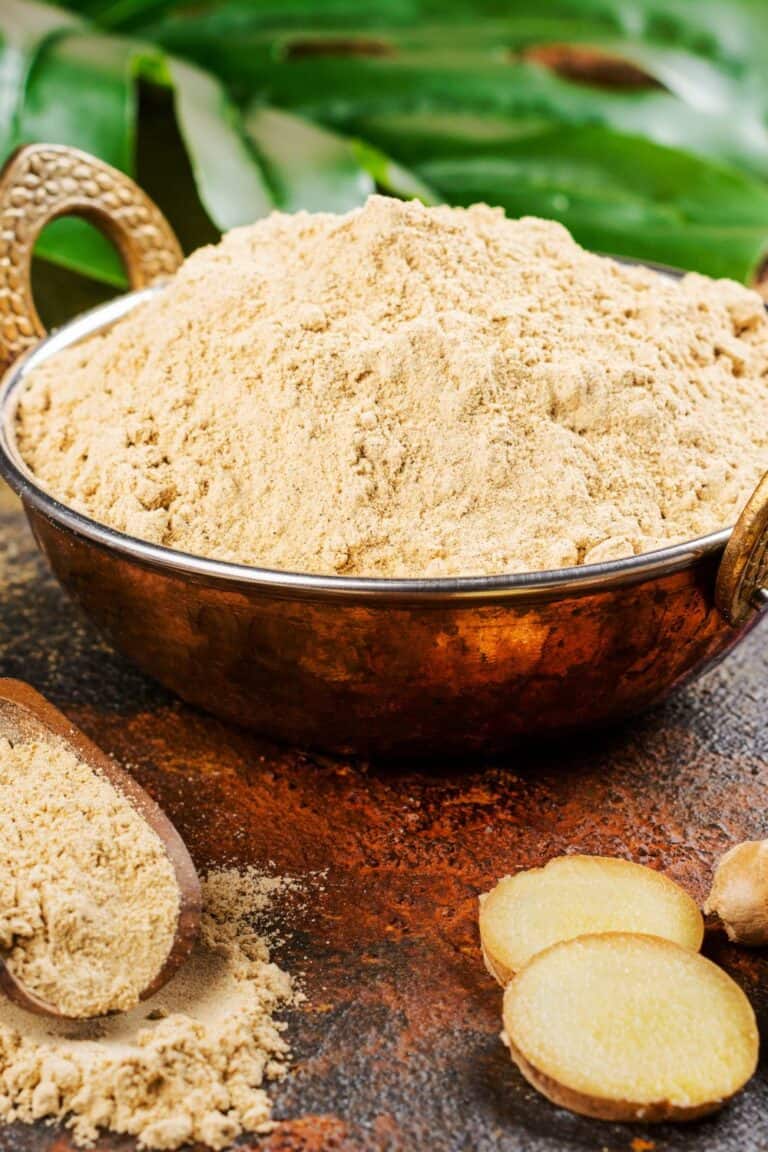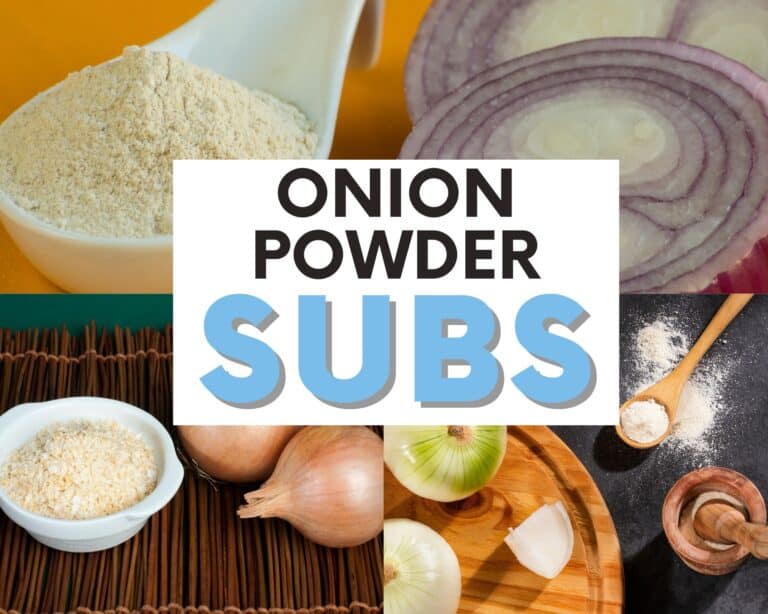Discover the BEST Turmeric Powder Substitutes
This post may contain affiliate links. Please see my disclosure policy for details.
I’m a fan of turmeric! I love it’s gritty, pungent flavor that goes well with so many things. And a cool fact is that it is related to ginger. Very few ingredients in the kitchen have the same advantages and flavor profile as turmeric.
It brightens the color of stews, curries, grains, sauces, baked products, and drinks. Plus, it has a wonderful citrus and ginger scent and flavor. However, turmeric is difficult to imitate. This is why I’ve found the best turmeric powder substitutes.
So, if you’ve run out of turmeric, don’t worry. Here’s a fantastic rundown of items you can use instead. There are a few factors to consider, including how much turmeric is used in a dish.
We will also guide you on how to use these alternatives. Apart from this, you can choose to imitate the coloring and flavor to obtain the best of each in your dish.
What Is Turmeric and What Does It Taste Like?
Let’s talk about turmeric before we find a good swap. That gorgeous golden spice that’s been winning hearts and taste buds all over the world. It starts its journey as a rhizome, kinda like ginger (distant relative), and it’s got this beautiful earthy yellow/orange color.
To make that peppy powder we all love, the rhizomes are dried and ground up. Now let’s break down the flavor explosion that is turmeric:
- Earthy: Like a warm hug from Mother Nature, it’s got this grounded taste
- Bitter: A little sass, just to keep things interesting
- Warm: Cozy and inviting, like your favorite sweater on a chilly day
- Slightly pungent: It’s got some zing to it, making every bite memorable
There you have it—turmeric in a nutshell. Now, let’s find the perfect turmeric replacement!
Substitutes for Turmeric

1. Saffron
Saffron is known as the most expensive spice in the world, and for good reason! It comes from the stigmas of the Crocus sativus flower and has an intense, slightly sweet, and floral flavor. Just a pinch of this red gold can turn any dish into a culinary masterpiece.
How to Use Saffron as a Substitute for Turmeric
When using saffron as a substitute for turmeric powder, keep in mind that less is more. Remember, we’re going for that “Yum!” factor without overpowering the dish.
Start by using just a couple of strands or a small pinch of saffron threads, and adjust according to taste and color.
To get the most flavor out of your saffron, gently toast the threads in a warm pan for a minute or two, and then grind them into a fine powder using a mortar and pestle.
You can also steep the threads in a bit of hot water, milk, or broth for about 15 minutes to create a beautiful infusion that can be added directly to your dish.
Pros and Cons of Using Saffron as a Substitute
Let’s break it down:
Pros:
- Unique and exotic flavor profile
- Imparts a beautiful golden hue to dishes
- A little goes a long way
Cons:
- More expensive than turmeric powder
- It can be overpowering when using too much
- Not ideal for recipes that require large amounts of turmeric
2. Curry Powder
Curry powder is a magical blend of various spices, with the main stars being coriander, cumin, and, you guessed it, turmeric!

This combo creates a warm, earthy, and slightly sweet flavor that can add depth and complexity to any dish. Plus, since turmeric is already part of the mix, you’ll still get that gorgeous golden hue we all love.
How to Use Curry Powder as a Substitute for Turmeric
Swapping turmeric with curry powder is a piece of cake! Start by using the same amount of curry powder as the turmeric called for in your recipe.
Keep in mind that curry powder has a more complex flavor profile than turmeric alone. And some curry powders pack a punch of heat. So, feel free to adjust the amount according to your taste buds.
Pros and Cons of Using Curry Powder as a Substitute
Let’s weigh our options, shall we?
Pros:
- Widely available and affordable
- Contains turmeric, so you’ll still get that golden color and a little of that pungent flavor
- Adds depth and complexity to dishes
Cons:
- The flavor profile differs from pure turmeric
- It may alter the taste of the original recipe
- It can be overpowering if used in excess
3. Annatto
Annatto, also known as achiote or roucou, is a popular spice in Latin American and Caribbean cuisine. Its slightly sweet, peppery, and nutty flavor profile brings warmth and depth to any dish.

And let’s not forget its stunning reddish-orange hue that’s perfect for replicating turmeric’s vibrant golden tones.
How to Use Annatto as a Substitute for Turmeric
When using annatto as a turmeric stand-in, start by substituting equal parts annatto powder for turmeric powder.
Keep in mind that annatto’s flavor is a bit different than turmeric, so be prepared to taste and adjust as you go.
If you’re working with annatto seeds, gently toast them in a warm pan for a minute or two, then grind them into a fine powder using a mortar and pestle or a spice grinder.
Alternatively, you can create an annatto-infused oil by simmering the seeds in a neutral oil for a few minutes, then straining and using the oil in your recipe.
Pros and Cons of Using Annatto as a Substitute
Let’s break it down, my friends:
Pros:
- Imparts a vibrant reddish-orange color to dishes
- Unique and earthy flavor profile
- Widely used in Latin American and Caribbean cuisine
Cons:
- The flavor profile differs from turmeric
- It may be harder to find than other substitutes
- It can be overpowering like curry
4. Paprika
Paprika is a ground spice made from dried red peppers, and it comes in various forms, from sweet to hot and even smoked. (smoked is my favorite!)
Its warm and slightly sweet flavor profile makes it a wonderful addition to a wide range of dishes, and its rich red color can help mimic the golden hue of turmeric when used in moderation.
How to Use Paprika as a Substitute for Turmeric
When using paprika as a turmeric stand-in, start by substituting equal parts paprika for turmeric powder. If you are scared you can even try half the amount. Just taste and adjust as needed.
For recipes that call for a more subtle touch, try using sweet or mild paprika. If you’re feeling adventurous and want to add an extra layer of depth, go for smoked paprika. And if you LOVE heat then try hot paprika. Too many, paprikas right?
Just keep in mind that the smokiness or heat may alter the original flavor of the dish, so use it sparingly and taste as you go.
Pros and Cons of Using Paprika as a Substitute
Let’s see where paprika stands:
Pros:
- Adds a warm, slightly sweet flavor to dishes
- Imparts a rich red color
- Widely available and affordable
Cons:
- The flavor profile differs from turmeric
- Smoked paprika may alter the taste of the original recipe
- It can be overpowering if used with a heavy hand
5. Mustard Powder
Mustard powder, made from ground mustard seeds, boasts a tangy, slightly bitter, and pungent flavor profile that can add an exciting twist to your recipes.

While its taste is quite different from turmeric, it still brings that warm and earthy depth we all love. Plus, mustard powder has a yellow hue that can look like turmeric’s golden touch to your dishes.
How to Use Mustard Powder as a Substitute for Turmeric
To use mustard powder as a turmeric stand-in, start by substituting half the amount of mustard powder for turmeric powder. Since mustard powder has a more potent flavor, it’s best to use less and adjust according to taste.
Remember, we’re going for that perfect balance of flavors that’ll make your dish sing!
If you find the mustard flavor too strong, consider combining it with another mild spice, like paprika or even a pinch of ginger, to help tone it down and create a more harmonious blend.
Pros and Cons of Using Mustard Powder as a Replacement
Let’s check out those pros and cons!
Pros:
- Adds a tangy and bold flavor to dishes
- It has that yellow color like turmeric (not as strong)
- Widely available and affordable
Cons:
- The flavor profile differs significantly from turmeric
- It can be overpowering and strong
- It may require additional spices to balance the flavor
6. Safflower
Safflower, derived from the dried petals of the safflower plant, boasts a mild and slightly sweet flavor profile. While its taste is more subtle than turmeric, it still brings a lovely touch of warmth to your dishes.
And let’s not forget about the beautiful yellow color that it gives off!

How to Use Safflower as a Substitute for Turmeric
To use safflower as a turmeric replacement, start by substituting equal parts of safflower petals for turmeric powder. Since safflower has a milder flavor, feel free to adjust the amount according to your taste buds.
Remember, we’re aiming for that perfect harmony of flavors that’ll make your dish a crowd-pleaser!
If you’re working with whole safflower petals, gently crush them between your fingers or grind them into a fine powder using a mortar and pestle.
You can also create a safflower-infused oil by simmering the petals in a neutral oil for a few minutes, then straining and using the oil in your recipe.
Pros and Cons of Using Safflower as a Substitute
Let’s rank Safflower:
Pros:
- Adds a subtle warmth and sweetness to dishes
- It imparts a lovely yellow color, similar to turmeric
- Way more affordable than saffron
Cons:
- The flavor profile is milder than turmeric
- It may require additional spices to boost the flavor
- It can be challenging to find in some grocery stores
7. Ginger Powder
Ginger powder, made from dried and ground ginger root, boasts a warm, spicy, and slightly sweet flavor profile that can add depth to most recipes.
While its taste is distinct from turmeric, it still brings that earthiness and warmth we all adore.
Keep in mind that ginger powder is turmerics’ cousin, but it lacks the golden hue of turmeric.
How to Use Ginger Powder as a Substitute for Turmeric
When using ginger powder as a turmeric swap, start by substituting half the amount of ginger powder for turmeric powder. Since ginger powder has a stronger, spicier flavor, it’s best to use less and adjust according to taste.
If you find the ginger flavor too dominant, consider combining it with another mild spice, like paprika or even a bit of mustard, to help balance it.
Pros and Cons of Using Ginger Powder as a Substitute
Let’s break this down, my friends:
Pros:
- Adds a warm, spicy, and slightly sweet flavor to dishes
- Widely available and affordable
- It pairs well with other spices
Cons:
- The flavor profile differs significantly from turmeric
- It lacks the golden color of turmeric
- It can be overpowering and strong.
Spices I DON’T Recommned for Replacing Turmeric
The spices above are my top 7 when it comes to using an alternative to turmeric. But I also have a list of 7 “Don’t Do That” spices. Just in case you are tempted to jump off the bandwagon. Please don’t do it!
- Cinnamon: While warm and sweet, cinnamon has a completely different taste and lacks the earthy, mild bitterness of turmeric.
- Nutmeg: Nutmeg’s sweet, nutty, and slightly spicy flavor is far from the earthiness of turmeric, making it an unsuitable substitute.
- Cloves: With their strong, sweet, and somewhat bitter taste, cloves are too overpowering and distinct to be used as a turmeric substitute.
- Allspice: Its blend of cinnamon, nutmeg, and clove flavors makes allspice too sweet and aromatic to effectively replace turmeric.
- Cardamom: The unique combination of sweet, spicy, and floral notes found in cardamom sets it apart from turmeric’s earthy and mild flavor.
- Fennel seeds: With their sweet, licorice-like taste, fennel seeds are not suitable to replace the mild, earthy flavor of turmeric.
- Star anise: The strong licorice flavor of star anise is too distinct and overpowering to be used as a turmeric substitute.
What About Using Fresh Turmeric?

To swap out dried turmeric powder for fresh turmeric root, simply use three times the amount of fresh grated turmeric as you would the dried version.
For example, if a recipe calls for one teaspoon of dried turmeric powder, go ahead and use three teaspoons of freshly grated turmeric root.
Just remember to wear gloves while grating, ’cause that golden hue loves to hang around on your fingertips! And your clothes…trust me I’ve made a hot mess one time when messing with fresh turmeric.
My Final Thoughts…
Well, there you have it, my fellow cooks! We’ve explored some fantastic turmeric substitutes, like curry powder, annatto, paprika, mustard powder, safflower, and ginger powder, each bringing its own unique twist to your recipe.
Remember, the key to successful substitution is finding that perfect harmony of flavors and colors that’ll make your dishes not even realize it’s missing turmeric!
So, go ahead, get creative in the kitchen, and don’t be afraid to experiment with these amazing alternatives. Happy cooking!






